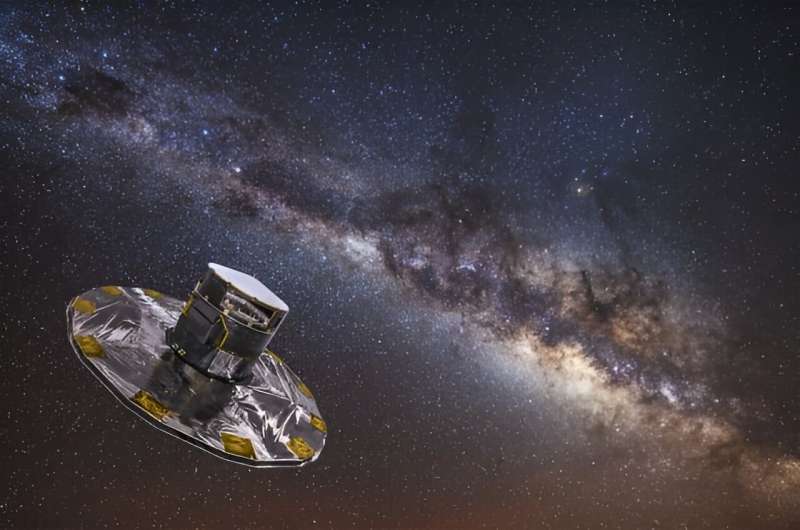This article has been reviewed according to Science X's editorial process and policies. Editors have highlighted the following attributes while ensuring the content's credibility:
fact-checked
peer-reviewed publication
trusted source
proofread
Gaia is so accurate it can predict microlensing events

The ESA's Gaia Observatory continues its astrometry mission, which consists of measuring the positions, distances, and motions of stars (and the positions of orbiting exoplanets) with unprecedented precision. Launched in 2013 and with a five-year nominal mission (2014–2019), the mission is expected to remain in operation until 2025. Once complete, the mission data will be used to create the most detailed 3D space catalog ever, totaling more than 1 billion astronomical objects—including stars, planets, comets, asteroids, and quasars.
Another benefit of this data, according to a team of researchers led by the Chinese Academy of Sciences (CAS), is the ability to predict future microlensing events. Similar to gravitational lensing, this phenomenon occurs when light from background sources is deflected and amplified by foreground objects. Using information from Gaia's third data release (DR3), the team predicted 4,500 microlensing events, 1,664 of which are unlike any we have seen. These events will allow astronomers to conduct lucrative research into distant star systems, exoplanets, and other celestial objects.
The team consisted of researchers from the Yunnan Observatories, the Key Laboratory for the Structure and Evolution of Celestial Objects, the Center for Astronomical Mega-Science, the University of Chinese Academy of Sciences (UCAS), and the College of Information Engineering at Kunming University. The preprint of their paper, "Predicting Astrometric Microlensing Events from Gaia DR3," was recently posted online, and an updated version was published on November 7 in the Monthly Notices of the Royal Astronomical Society.
Gravitational lensing has proven to be of immense value to astronomers, allowing for observation campaigns like the Frontier Fields program. This consisted of the venerable Hubble Space Telescope using lenses created by massive galaxy clusters to take the deepest views of the universe ever and observe galaxies that existed about 1 billion years after the Big Bang. The James Webb Space Telescope has carried on in this tradition and recently collaborated with Hubble to produce even more detailed images of lensing galaxies.
While similar in principle, microlensing has a different range of applications, including detecting and studying exoplanets and constraining the population of binary stars, neutron stars, brown dwarfs, and red dwarfs in our galaxy. But as lead author Su Jie told Universe Today via email, the applications go much farther:
"Astrometric microlensing can be used to make precise measurements of the masses of lens stars that are independent of their assumed internal physics. Such direct mass measurements, obtained purely by observing the gravitational effects of the stars on external objects, are crucial for validating theoretical stellar models. In addition, it can also detect faint and compact lenses such as isolated neutron stars and black holes because the luminosity of the lens is not necessarily measured."
Like Gravitational Lensing, the Microlensing technique depends on chance alignments between massive objects and background sources. Given their importance to astronomers, the ability to predict when these microlensing events will occur is vitally important. This is where the ESA's Gaia Observatory comes into play. For years, Gaia has gathered accurate information on the position, proper motion, and velocity of stars and other celestial objects in our Milky Way—which will be used to create the most detailed 3D space catalog ever made.
To predict future microlensing events, Su Jie and his colleagues examined 820,000 potential lens stars obtained from Gaia's third data release (DR3). They also conducted mass estimates to determine the size of the lensing event and where and when the proper alignments would happen between now and 2070. Said Su Jie:
"This information allows the future on-sky separation between a lens and source to be calculated as seen from Earth. Using data from Gaia Data Release 3, we predict 4,500 astrometric microlensing events with a peak astrometric shift more than 0.1 mas. There are 293 lens stars that can cause two or more events, where five lens stars can cause more than 50 events. The detection of many events caused by one lens will help us to improve lens mass accuracy."
The cone search method they employed, where the search range expands for each potential lens star, could also reduce the possibility of missing future events. Moreover, added Su Jie, the stars and microlensing events they identified could be the subject of follow-up observations by Hubble, the James Webb Space Telescope (JWST), and the proposed Chinese Space Station Telescope (CSST)—aka. Xuntian, Chinese for "sky survey," which China plans to launch sometime next year.
More information: Jie Su et al, Predicting astrometric microlensing events from Gaia Data Release 3, Monthly Notices of the Royal Astronomical Society (2023). DOI: 10.1093/mnras/stad3022. On arXiv: DOI: 10.48550/arxiv.2310.20176
Journal information: Monthly Notices of the Royal Astronomical Society , arXiv
Provided by Universe Today





















